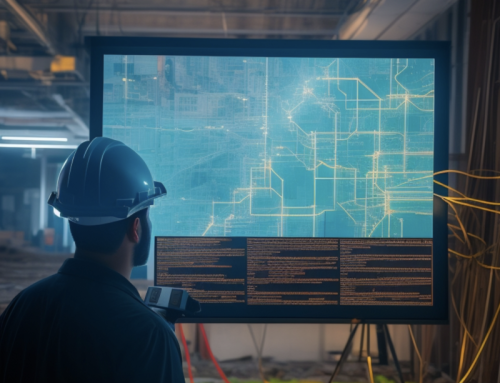Daily planning conversations are the window into your organization. Do you like what you see and hear?
What’s the takeaway here? If the organization isn’t concerned with the quality of their crews and teams conversations, you are likely to have more risk and unlikely to get better. I’ll start at the beginning. I’ve been interested and attentive to daily planning conversations for a long time. My career began in the nuclear industry and continued into insurance loss control and safety consulting. I’ve worked with Fortune 500 companies, large and mid-sized companies and even small, three-man operations. When it comes to success in the field, the thing that matters most is the level of engagement of the workforce. More engaged workers had better awareness of the environment, better ideas on working safely and productively, and better outcomes. It really comes down to organizational leadership setting goals and strategy and then staying actively engaged. So where do you start? Daily planning conversations? They’re called JHAs, safety meetings, plans of the day, pre-task plans…all kinds of names. The conversations within these start of the day meetings set the stage for a good day at work.
I’ve led these meetings, participated in them, and observed many more. With that background, I started the journey of evaluating many more meetings here at FactorLab. What I see is everyone tries their best to have a great meeting, and that was evident. After viewing and listening to many of these conversations, it is clear we can do better. Why are daily morning meetings so important to an organization’s operations? Because these meetings set the tone for a safe and productive day. But it’s not just the idea of having a meeting. It’s about having an effective meeting that provides instruction, coordination, and thoughtful, authentic conversation. It’s about having dialogue, not a leader’s monologue. Words and language are essential components of effective meetings. Thoughtful words and language can transform an organization from a compliance state to an engagement state. What does that mean? The compliance state is where the topic is typically about what PPE is required, what tool and equipment inspections will be performed, etc. In this state, the idea of staying free from injury is more focused on safety compliance. The engagement state is where the crew, those closest to the work, talk about the preparation to perform the task, the physical actions involved, the barriers to doing the task safely, alternative methods of doing the work, safer and more efficient methods to do the work, etc. See the difference? Compliance is about things; engagement is about thinking. Why is this a big deal?
Like most plans, things change so you have to adjust. There may be major changes that occur or small changes. Think of the crew out on their own, like it usually is. You come to a decision point. Keep going, adjust, or stop. What information is used in making the decision? The changes will most likely be recognized by the worker. An engaged worker would have a better view of the situation and use the information he has learned earlier. A compliant worker will have a narrower view and make a decision or choice based on his sometimes-limited knowledge. This article explores how advancements in Natural Language Processing (NLP), Artificial Intelligence (AI), and innovative applications, like FactorLab’s SmartTagIt, can help organizations better understand and improve these vital meetings, leading to a more engaged workforce, enhanced safety culture, and improved overall performance.
The Problem with Traditional Daily Meetings:
As I said before, throughout my career I have been involved in daily meetings. As I reflected on this experience, I realized there were many variables that led to the outcomes of the meetings. There is the personality and style of the leader, the engagement of the team, the level of detail discussed, the level of trust and respect, the freedom to disagree and many other variables. The variables and their extent steer meetings towards compliance or engagement and the resulting culture. It has taken me a lifetime to better understand the significance of an organization’s view towards their workforce. The organization is responsible for choosing the culture it desires. People will follow directions. The problem is there is not always a clear direction, leaving the workforce to make the best effort of what it thinks is desired by the organization’s leaders.
I believe engagement of the workforce is the difference maker for an organization. Another way to think about this idea of compliance versus engagement is Sidney Dekker’s view of “safety differently.” This idea can change the way an organization functions. A change for the betterment of all. Todd Conklin describes these four principles of “safety differently” as follows:
- Safety is not defined by the absence of accidents, but the presence of capacity (improvements to processes, systems, planning and operations).
- Workers aren’t the problem; workers are the problem solvers.
- We don’t constrain workers in order to create safety, we ask workers what they need to do work safely, reliably and productively.
- Safety doesn’t prevent bad things from happening, safety ensures good things happen while workers do work in complex and adaptive work environments.
After analyzing hundreds of daily planning meetings using NLP and AI, a pattern emerged that indicated employees often provided the information they believed management wanted to hear, influenced by rewards and penalties. Many meetings were found to lack proper structure, openness, and leader effectiveness, resulting in missed opportunities for improvement. Good conversations were far outweighed by subpar ones, with a ratio of three or four to one. Why is this occurring? FactorLab works with clients in the field. At one client, the manager observed a less-than-desirable meeting. “It didn’t used to be like this,” he said. They got into a discussion with the crew. “Why do we have these meetings?” they asked the crew. The response was, “It’s for the company to cover their butts.” Somehow, this crew lost the intent of this meeting and that the discussion is for their benefit, for a safe and productive day. That’s an example but it seems fair to view this as representative of other companies and their crews
Why is this important? Straight talk about the scope of work and hazards at the start of the day provides information necessary for crews to think about and make decisions as the day progresses. This requires crew engagement and the realization that they have a lot to do with how well the day goes.
Experts in organizational safety culture, like Dr. Todd Conklin, emphasize that those doing the work understand it best and how to perform it safely. One time when I was a supervisor, I was assigned to repair a complex pump in a short amount of time. I informed the person I selected to lead the work of the upcoming job. He proceeded to tell me the preparation we needed to do, materials to check for availability, tools and equipment, special details to cut down on time and who he wanted to assist. What about safety you ask? It was inherent in his language. Needless to say, I gave him the reins and it worked out great. .Those closest to the work know the best.
Unfortunately, this worker knowledge is not always effectively utilized by organizational leaders, who may hold misguided beliefs about their workforce. Technological advancements now provide organizations with the ability to observe the culture of the organization, validate their beliefs, make adjustments and celebrate great conversations-all in nearly real-time.
The Role of Technology and NLP: FactorLab’s SmartTagIt Application
FactorLab has developed a unique application that allows project teams to easily use their mobile devices to record and share their daily planning conversations. FactorLab’s SmartTagIt application automatically transcribes the conversation and breaks it into thousands of unique features. These features can accurately identify if a conversation is high in care, certain types of hazards, question quality, planning, participant engagement, and leadership maturity. Each conversation is then clustered on each of these predictions, allowing organizations to see tens of thousands of conversations measured on seven dimensions in one chart. This innovative approach enables leaders to better uncover hidden opportunities for training, system health improvement, and leadership coaching. I use this tool to continue my Journey of 1000 Conversations.
Creating a Psychologically Safe Environment
To improve daily planning conversations, organizational leaders must create a psychologically safe environment that encourages open dialogue, collaboration, and better performance. Dr. Amy Edmondson, an expert in teaming and psychological safety, explains that one of the primary reasons people do not speak up is the perceived risk to themselves or the organization. I remember many types of personalities, both leaders and crews. I recognized the disgruntled employee, the bashful employee, the bully, the jokester, etc. Leaders need to steer the conversation back to the scope of work and take action to minimize the impact of the disrupter. Over time, the crew appreciates it. Yes, leaders need to have the idea of a safe environment in mind.
An effective meeting should address care, engagement, planning, and hazards. Care is clear trust and respect for one another. Engagement means the team actively participates in a beneficial manner, with the leader prompting thoughtful responses and fostering dialogue among crew members. Planning ensures everyone understands the day’s work expectations. Hazards are the risk exposures, in the general environment as well as well as for specific tasks. By addressing these elements, organizations can create a step-change in their culture. But first, the organization has to show them what it wants or they view it as just a CYA activity by the organization.
Leadership’s Role in Driving Change
Organizational leadership should establish operational norms that prioritize safety, safe work practices, and employee health. Providing guidance on daily planning meetings, piloting change, offering coaching, and recognizing good techniques can drive engagement and performance. But, you have to show them what you want.
For example, one conversation I observed featured a worker who stood out by providing a detailed statement about his plan of work and a potential hazard. However, the leader minimized the worker’s efforts and moved on without engaging in follow-up questions. This was a missed learning opportunity for the crew, as the leader could have facilitated a more in-depth conversation, allowing others on the crew to benefit from the shared knowledge. And if the conversation was observed by leadership, they could celebrate the worker (in public) and coach the leader. (in private)
The Competitive Edge
An engaged and communicative workforce is foundational to a competitive edge. Organizations that recognize the value of engagement, communication, and leadership can establish such an advantage. Implementing a system to benchmark performance and identify specific areas for improvement can lead to a continuous improvement cycle, benefiting the organization. By promoting open communication and focusing on the effectiveness of daily planning meetings, organizations can create a positive shift in safety culture and overall performance. The technology allows you to create the organization you want. Are you ready for your Journey?





